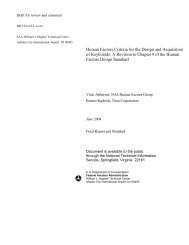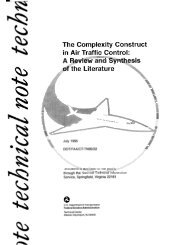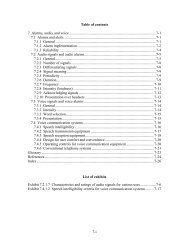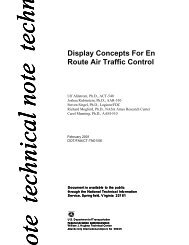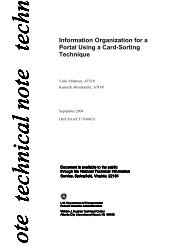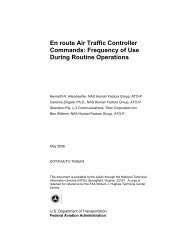Design of information Display Systems for Air Traffic Control - FAA
Design of information Display Systems for Air Traffic Control - FAA
Design of information Display Systems for Air Traffic Control - FAA
You also want an ePaper? Increase the reach of your titles
YUMPU automatically turns print PDFs into web optimized ePapers that Google loves.
users to per<strong>for</strong>m normal operations. These evaluation methods will identify any gaps in the<br />
<strong>in<strong>for</strong>mation</strong> available in the system and any usability issues that need to be addressed.<br />
3.2.4 Notifications<br />
Current IDSs provide notifications <strong>of</strong> <strong>in<strong>for</strong>mation</strong> updates. Based on our findings, however,<br />
today’s systems produce notifications <strong>for</strong> events that do not require them, do not produce<br />
notifications <strong>for</strong> events that do require them, and provide inappropriate levels <strong>of</strong> notifications.<br />
The Specialists described two categories <strong>of</strong> <strong>in<strong>for</strong>mation</strong>: <strong>in<strong>for</strong>mation</strong> that directly affects their<br />
primary task <strong>of</strong> ATC and <strong>in<strong>for</strong>mation</strong> that they used as reference. When new <strong>in<strong>for</strong>mation</strong> is<br />
available that directly affects their primary task (e.g., new NOTAM is issued <strong>for</strong> their area <strong>of</strong><br />
control), the system should notify them with an alarm. However, if reference <strong>in<strong>for</strong>mation</strong> is<br />
updated (e.g., <strong>FAA</strong> orders), the system should provide an indication <strong>of</strong> when the update occurred<br />
but should not distract the Specialist or require a response.<br />
In addition, notifications should be tailored to the user’s responsibilities. <strong>Systems</strong> that produce<br />
alarms or alerts that are irrelevant to the user quickly become nuisances and lose their<br />
effectiveness to draw the user’s attention. The Specialists described that some <strong>of</strong> the<br />
notifications provided by the IDSs in the field are already regarded as nuisance alarms and are<br />
typically ignored.<br />
One very important finding regarding system notifications is that the notification should never<br />
stop the Specialist from continuing what they were doing by locking the display or covering it up<br />
with a warning message. The time criticality <strong>of</strong> many ATC tasks may require that the Specialist<br />
complete a task be<strong>for</strong>e responding to even the most urgent notification. Some <strong>of</strong> the IDSs used<br />
in the field today prevent the user from doing anything on the system until they acknowledge the<br />
alarm. This interrupts the Specialist’s workflow and reduces efficiency.<br />
Standard 4: An IDS shall provide effective notifications.<br />
Notifications on an IDS can draw the user’s attention to important <strong>in<strong>for</strong>mation</strong>. Whether it is an<br />
emergency or a change in status, notifications ensure that the user is aware <strong>of</strong> the <strong>in<strong>for</strong>mation</strong>.<br />
A notification can be highly salient and attention getting or very subtle. For example, an<br />
emergency situation usually requires an immediate response and should draw the user’s<br />
attention. An update to reference <strong>in<strong>for</strong>mation</strong>, however, is typically not something that the user<br />
has to be made aware <strong>of</strong> immediately. In that case, a notification that the user will notice when<br />
accessing that piece <strong>of</strong> <strong>in<strong>for</strong>mation</strong> may be more appropriate. Notifications <strong>of</strong> critical<br />
<strong>in<strong>for</strong>mation</strong> that require an immediate response are <strong>of</strong>ten referred to as alarms, whereas those<br />
that do not call <strong>for</strong> immediate action but are operationally relevant are referred to as alerts (HF-<br />
STD-001, 7.1.2.5-8). Alarms may produce an audible signal to draw the user’s attention if it is<br />
directed elsewhere, while alerts may only require a visual indication. The design <strong>of</strong> alarms and<br />
alerts <strong>for</strong> any new system is a difficult task. We found that designers need operational input to<br />
determine which types <strong>of</strong> events require alarms and which types require alerts.<br />
We recommend the following guidelines to help maintain the user’s awareness <strong>of</strong> new<br />
<strong>in<strong>for</strong>mation</strong> without creating situations that interfere with their tasks or cause them to disregard<br />
the notification.<br />
16




